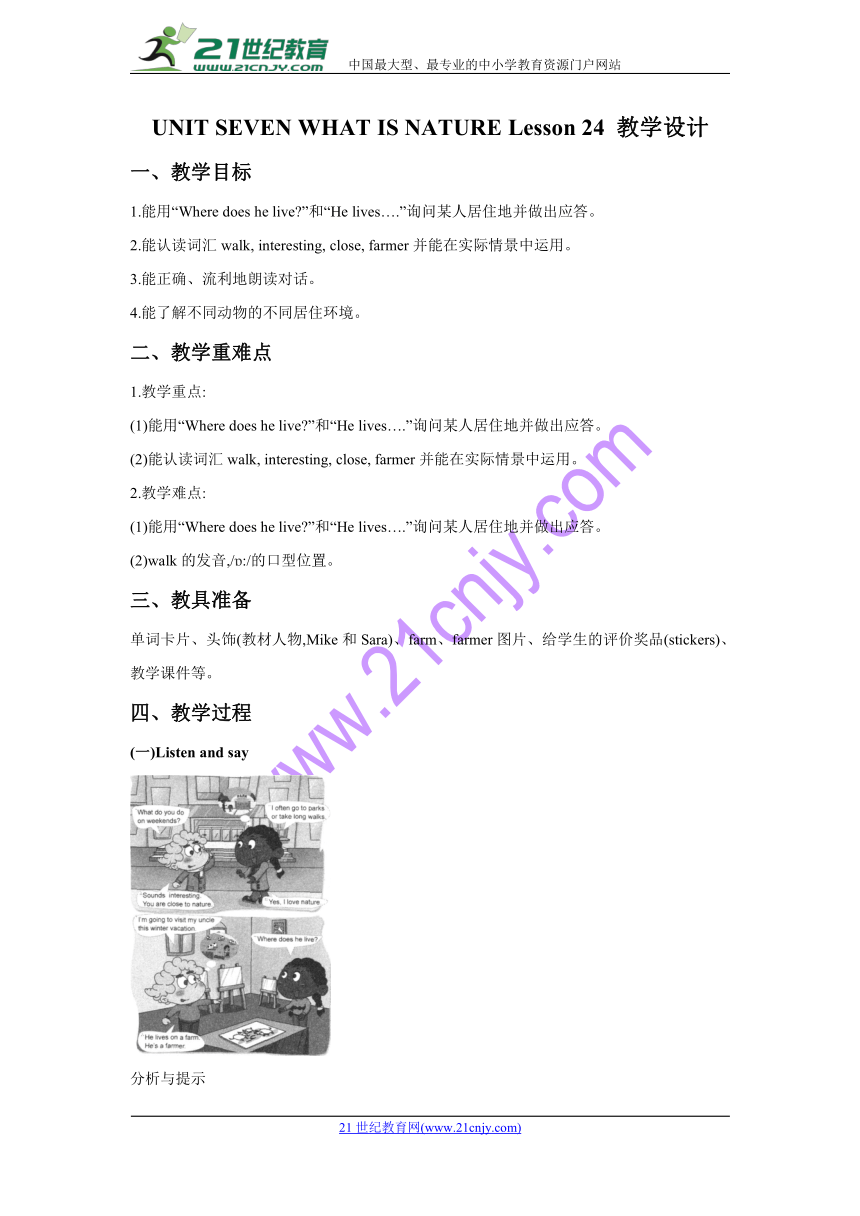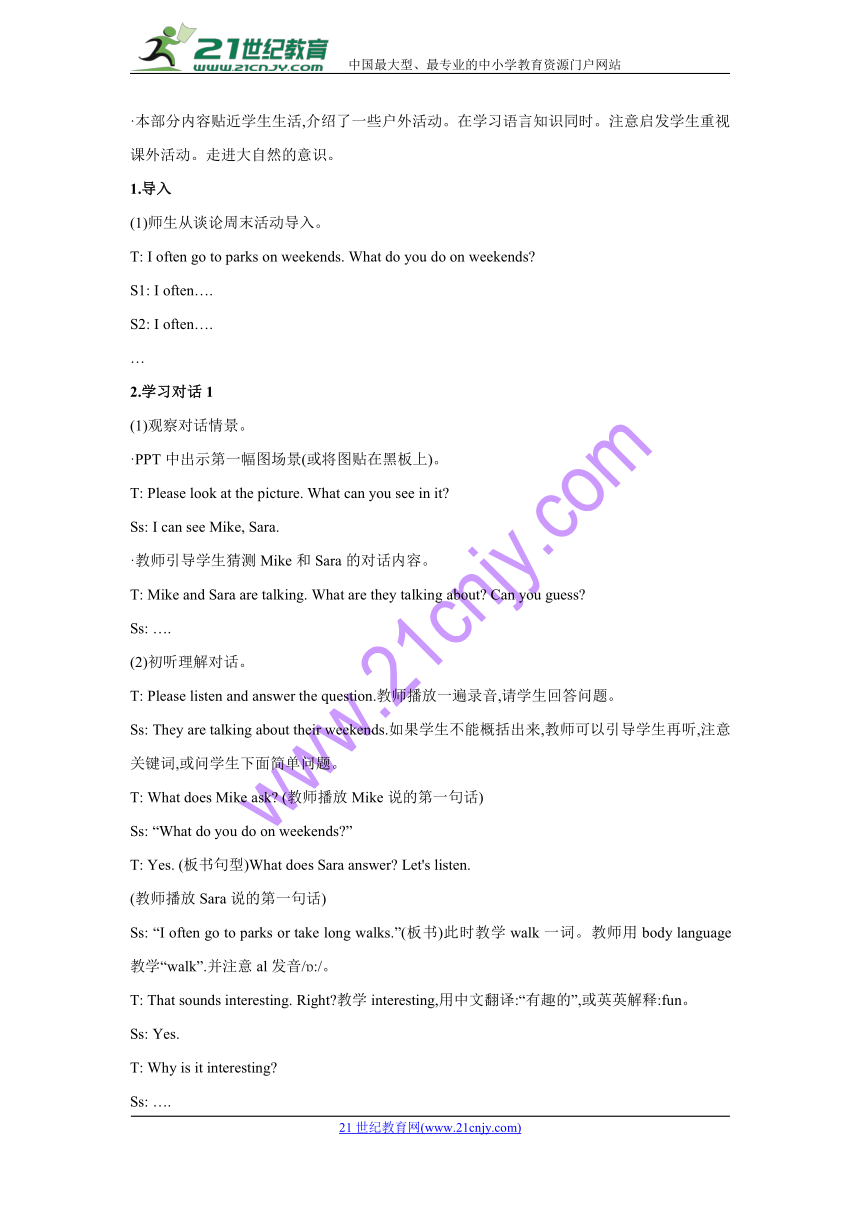Unit 7 What is nature Lesson 24 教学设计
文档属性
| 名称 | Unit 7 What is nature Lesson 24 教学设计 |  | |
| 格式 | zip | ||
| 文件大小 | 382.2KB | ||
| 资源类型 | 教案 | ||
| 版本资源 | 北京版 | ||
| 科目 | 英语 | ||
| 更新时间 | 2018-06-11 22:34:52 | ||
图片预览


文档简介
UNIT SEVEN WHAT IS NATURE Lesson 24 教学设计
一、教学目标
1.能用“Where does he live?”和“He lives….”询问某人居住地并做出应答。
2.能认读词汇walk, interesting, close, farmer并能在实际情景中运用。
3.能正确、流利地朗读对话。
4.能了解不同动物的不同居住环境。
二、教学重难点
1.教学重点:
(1)能用“Where does he live?”和“He lives….”询问某人居住地并做出应答。
(2)能认读词汇walk, interesting, close, farmer并能在实际情景中运用。
2.教学难点:
(1)能用“Where does he live?”和“He lives….”询问某人居住地并做出应答。
(2)walk的发音,/?:/的口型位置。
三、教具准备
单词卡片、头饰(教材人物,Mike和Sara)、farm、farmer图片、给学生的评价奖品(stickers)、教学课件等。2-1-c-n-j-y
四、教学过程
(一)Listen and say
分析与提示
·本部分内容贴近学生生活,介绍了一些户外活动。在学习语言知识同时。注意启发学生重视课外活动。走进大自然的意识。21*cnjy*com
1.导入
(1)师生从谈论周末活动导入。
T: I often go to parks on weekends. What do you do on weekends?【21cnj*y.co*m】
S1: I often….
S2: I often….
…
2.学习对话1
(1)观察对话情景。
·PPT中出示第一幅图场景(或将图贴在黑板上)。
T: Please look at the picture. What can you see in it?2·1·c·n·j·y
Ss: I can see Mike, Sara.
·教师引导学生猜测Mike和Sara的对话内容。
T: Mike and Sara are talking. What are they talking about? Can you guess?
Ss: ….
(2)初听理解对话。
T: Please listen and answer the question.教师播放一遍录音,请学生回答问题。
Ss: They are talking about their weekends.如果学生不能概括出来,教师可以引导学生再听,注意关键词,或问学生下面简单问题。【21教育名师】
T: What does Mike ask? (教师播放Mike说的第一句话)
Ss: “What do you do on weekends?”
T: Yes. (板书句型)What does Sara answer? Let's listen.【21教育】
(教师播放Sara说的第一句话)
Ss: “I often go to parks or take long walks.”(板书)此时教学walk一词。教师用body language教学“walk”.并注意al发音/?:/。21*教*育*名*师
T: That sounds interesting. Right?教学interesting,用中文翻译:“有趣的”,或英英解释:fun。
Ss: Yes.
T: Why is it interesting?
Ss: ….
T: Because it's close to nature.教学close,读作/kl?us/,形容词,读音与动词close/kl?uz/不同,中文意思也不同,意为“接近”。be close to nature,意为接近大自然。21-cnjy*com
T: Now please listen and read after them.
(3)听录音模仿跟读。
·教师播放对话录音,学生模仿跟读。
·学生集体朗读对话。
·学生自读对话,内化理解。
(4)角色扮演。
·学生2人一组分角色朗读对话。教师做出评价。
·教师找1~2组学生表演对话。
3.学习对话2
(1)教师PPT中出示第二幅图场景(或将图贴在黑板上)。
T: Please Look at the picture, listen and answer the question:21世纪教育网
What is Mike going to do this winter vacation? (教师播放录音,学生听后回答问题)
Ss: He is going to visit his uncle.
(2)初听理解对话。
教师再次播放录音,听录音前教师提问。
T: Where does Mike's uncle live? What does Mike's uncle do?21教育网
Ss: His uncle lives on a farm. He's a farmer. (同时教师板书,并贴上farmer图片,用图片教学farmer,由farm引出farmer)21cnjy.com
(3)听录音模仿跟读。
·播放对话录音,学生模仿跟读。
·学生集体朗读对话。
·学生自读对话,内化理解。
(4)角色扮演。
·学生分角色练习朗读对话。
·1~2组学生表演对话。教师做出评价。
(二)Listen, look, and learn
分析与提示
·本部分提供了五个不同的户外场景,供学生进行替换句型练习时使用,达到熟练运用所学句型的目的。提醒学生注意第三人称单数形式以及不同地点用不同的介词。
1.词汇学习
(1)教师呈现山、湖泊、森林、草原的图片,用图片教学生词:mountain, in the mountains; lake, by the lake; forest, in the forest: grassland, on the grassland.教师把这些图片放在农场的图片边上,用刚才学过的句型逐一进行替换练习。www.21-cn-jy.com
T: Where does he/she live?
Ss: He/She lives in the mountains/by the lake/in the forest/on the grassland.
(2)根据板书,全班问答、男女生问答、小组问答练习。
(3)找1~2组学生根据板书进行展示。教师做出评价。
2.巩固练习
(1)教师提供不同人物及地点的更多图片,在PPT上呈现,供学生巩固练习句型使用。
如:
(2)教师先给学生示范:“Where does Kate live? She lives on a farm.”【21·世纪·教育·网】
(3)学生2人一组练习。
(4)找2~3组学生全班展示。教师做出评价。
(三)Let's do
分析与提示
·本部分内容为不同动物居住在不同的环境中。学生仔细观察图片。在完成练习的同时。渗透保护自然意识。
在上一个环节的巩固练习部分,实际上已经练习了此部分内容。可以直接让学生自己做出答案,然后教师核对一下即可。注意给学生渗透保护环境意识。21·cn·jy·com
五、可供选择的教学活动
1.游戏:编句子
目的:练习有关地点的词汇,以及句型“Where does he/she live?”
教师事先写好不同人物与不同地点的单词卡片,放在不同的盒子或信封里,学生分别从两个不同的盒子或信封里任意拿出一张卡片,学生用拿到的两张卡片组合成句子。如:学生分别拿到了Kate's sister和in the forest的卡片,学生说出句子:“Kate's sister lives in the forest.”有可能学生拿到两张图片组合起来的句子很有趣或不合常理,没关系,目的是练习句型,同时还可增强课堂气氛。21·世纪*教育网
2.小组活动:走进大自然
目的:提高学生的环保意识。
教师提问:“What will you do to be close to nature?”学生小组中各抒己见,共同提供走进大自然、增强环保意识、爱护大自然(go to parks, go camping, plant trees, clean the forest, be kind to animals, see the animals,…)的建议。www-2-1-cnjy-com
一、教学目标
1.能用“Where does he live?”和“He lives….”询问某人居住地并做出应答。
2.能认读词汇walk, interesting, close, farmer并能在实际情景中运用。
3.能正确、流利地朗读对话。
4.能了解不同动物的不同居住环境。
二、教学重难点
1.教学重点:
(1)能用“Where does he live?”和“He lives….”询问某人居住地并做出应答。
(2)能认读词汇walk, interesting, close, farmer并能在实际情景中运用。
2.教学难点:
(1)能用“Where does he live?”和“He lives….”询问某人居住地并做出应答。
(2)walk的发音,/?:/的口型位置。
三、教具准备
单词卡片、头饰(教材人物,Mike和Sara)、farm、farmer图片、给学生的评价奖品(stickers)、教学课件等。2-1-c-n-j-y
四、教学过程
(一)Listen and say
分析与提示
·本部分内容贴近学生生活,介绍了一些户外活动。在学习语言知识同时。注意启发学生重视课外活动。走进大自然的意识。21*cnjy*com
1.导入
(1)师生从谈论周末活动导入。
T: I often go to parks on weekends. What do you do on weekends?【21cnj*y.co*m】
S1: I often….
S2: I often….
…
2.学习对话1
(1)观察对话情景。
·PPT中出示第一幅图场景(或将图贴在黑板上)。
T: Please look at the picture. What can you see in it?2·1·c·n·j·y
Ss: I can see Mike, Sara.
·教师引导学生猜测Mike和Sara的对话内容。
T: Mike and Sara are talking. What are they talking about? Can you guess?
Ss: ….
(2)初听理解对话。
T: Please listen and answer the question.教师播放一遍录音,请学生回答问题。
Ss: They are talking about their weekends.如果学生不能概括出来,教师可以引导学生再听,注意关键词,或问学生下面简单问题。【21教育名师】
T: What does Mike ask? (教师播放Mike说的第一句话)
Ss: “What do you do on weekends?”
T: Yes. (板书句型)What does Sara answer? Let's listen.【21教育】
(教师播放Sara说的第一句话)
Ss: “I often go to parks or take long walks.”(板书)此时教学walk一词。教师用body language教学“walk”.并注意al发音/?:/。21*教*育*名*师
T: That sounds interesting. Right?教学interesting,用中文翻译:“有趣的”,或英英解释:fun。
Ss: Yes.
T: Why is it interesting?
Ss: ….
T: Because it's close to nature.教学close,读作/kl?us/,形容词,读音与动词close/kl?uz/不同,中文意思也不同,意为“接近”。be close to nature,意为接近大自然。21-cnjy*com
T: Now please listen and read after them.
(3)听录音模仿跟读。
·教师播放对话录音,学生模仿跟读。
·学生集体朗读对话。
·学生自读对话,内化理解。
(4)角色扮演。
·学生2人一组分角色朗读对话。教师做出评价。
·教师找1~2组学生表演对话。
3.学习对话2
(1)教师PPT中出示第二幅图场景(或将图贴在黑板上)。
T: Please Look at the picture, listen and answer the question:21世纪教育网
What is Mike going to do this winter vacation? (教师播放录音,学生听后回答问题)
Ss: He is going to visit his uncle.
(2)初听理解对话。
教师再次播放录音,听录音前教师提问。
T: Where does Mike's uncle live? What does Mike's uncle do?21教育网
Ss: His uncle lives on a farm. He's a farmer. (同时教师板书,并贴上farmer图片,用图片教学farmer,由farm引出farmer)21cnjy.com
(3)听录音模仿跟读。
·播放对话录音,学生模仿跟读。
·学生集体朗读对话。
·学生自读对话,内化理解。
(4)角色扮演。
·学生分角色练习朗读对话。
·1~2组学生表演对话。教师做出评价。
(二)Listen, look, and learn
分析与提示
·本部分提供了五个不同的户外场景,供学生进行替换句型练习时使用,达到熟练运用所学句型的目的。提醒学生注意第三人称单数形式以及不同地点用不同的介词。
1.词汇学习
(1)教师呈现山、湖泊、森林、草原的图片,用图片教学生词:mountain, in the mountains; lake, by the lake; forest, in the forest: grassland, on the grassland.教师把这些图片放在农场的图片边上,用刚才学过的句型逐一进行替换练习。www.21-cn-jy.com
T: Where does he/she live?
Ss: He/She lives in the mountains/by the lake/in the forest/on the grassland.
(2)根据板书,全班问答、男女生问答、小组问答练习。
(3)找1~2组学生根据板书进行展示。教师做出评价。
2.巩固练习
(1)教师提供不同人物及地点的更多图片,在PPT上呈现,供学生巩固练习句型使用。
如:
(2)教师先给学生示范:“Where does Kate live? She lives on a farm.”【21·世纪·教育·网】
(3)学生2人一组练习。
(4)找2~3组学生全班展示。教师做出评价。
(三)Let's do
分析与提示
·本部分内容为不同动物居住在不同的环境中。学生仔细观察图片。在完成练习的同时。渗透保护自然意识。
在上一个环节的巩固练习部分,实际上已经练习了此部分内容。可以直接让学生自己做出答案,然后教师核对一下即可。注意给学生渗透保护环境意识。21·cn·jy·com
五、可供选择的教学活动
1.游戏:编句子
目的:练习有关地点的词汇,以及句型“Where does he/she live?”
教师事先写好不同人物与不同地点的单词卡片,放在不同的盒子或信封里,学生分别从两个不同的盒子或信封里任意拿出一张卡片,学生用拿到的两张卡片组合成句子。如:学生分别拿到了Kate's sister和in the forest的卡片,学生说出句子:“Kate's sister lives in the forest.”有可能学生拿到两张图片组合起来的句子很有趣或不合常理,没关系,目的是练习句型,同时还可增强课堂气氛。21·世纪*教育网
2.小组活动:走进大自然
目的:提高学生的环保意识。
教师提问:“What will you do to be close to nature?”学生小组中各抒己见,共同提供走进大自然、增强环保意识、爱护大自然(go to parks, go camping, plant trees, clean the forest, be kind to animals, see the animals,…)的建议。www-2-1-cnjy-com
同课章节目录
- Unit 1 Why are you so happy?
- Lesson 1
- Lesson 2
- Lesson 3
- Lesson 4
- Unit 2 May I speak to Mike?
- Lesson 5
- Lesson 6
- Lesson 7
- Lesson 8
- Unit 3 Will you do me a favour?
- Lesson 9
- Lesson 10
- Lesson 11
- Lesson 12
- Unit 4 Revision
- Lesson 13
- Lesson 14
- Unit 5 Which kind would you like?
- Lesson 15
- Lesson 16
- Lesson 17
- Lesson 18
- Unit 6 May I take your order?
- Lesson 19
- Lesson 20
- Lesson 21
- Lesson 22
- Unit 7 What is nature?
- Lesson 23
- Lesson 24
- Lesson 25
- Lesson 26
- Unit 8 Revision
- Lesson 27
- Lesson 28
